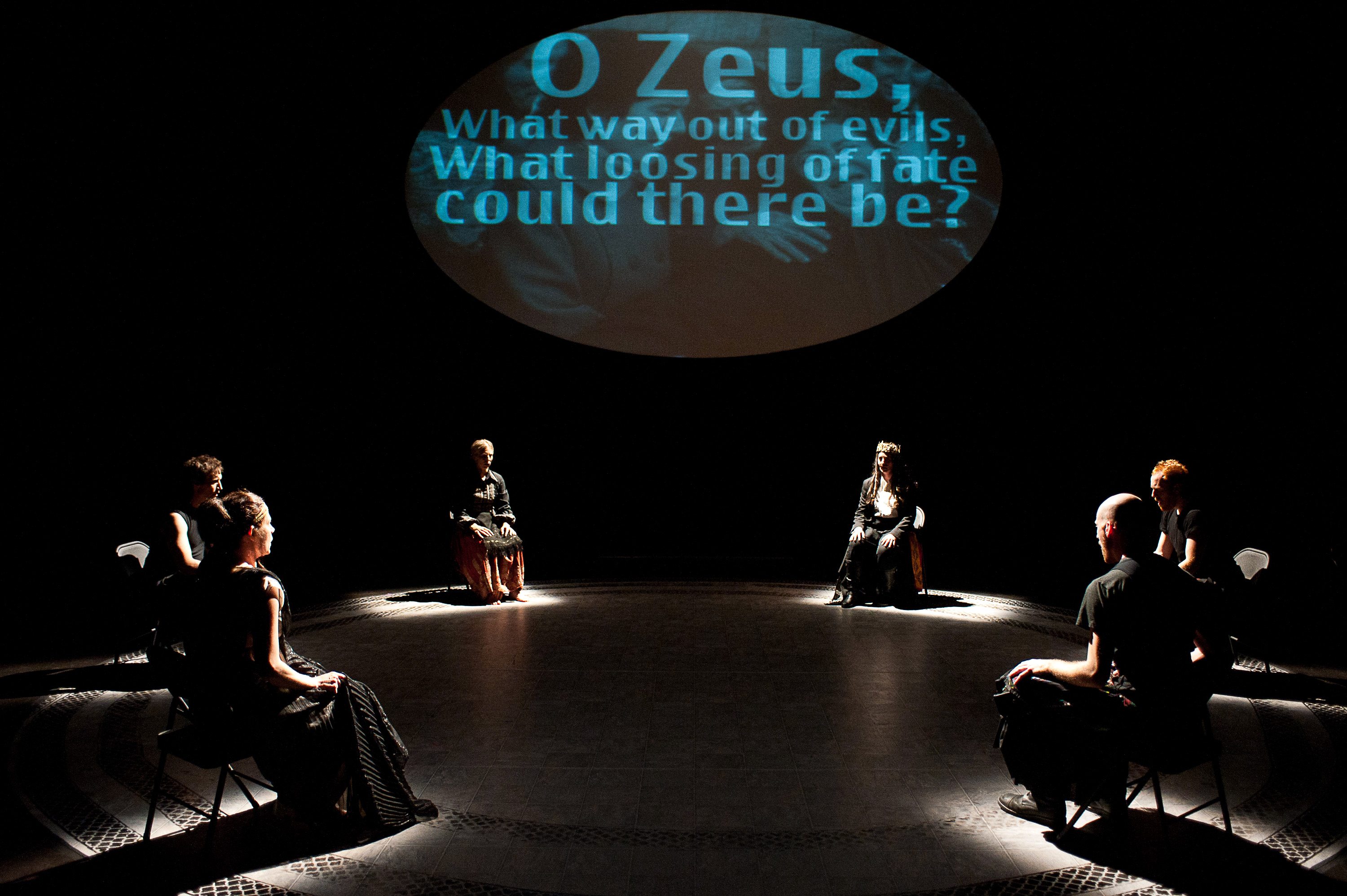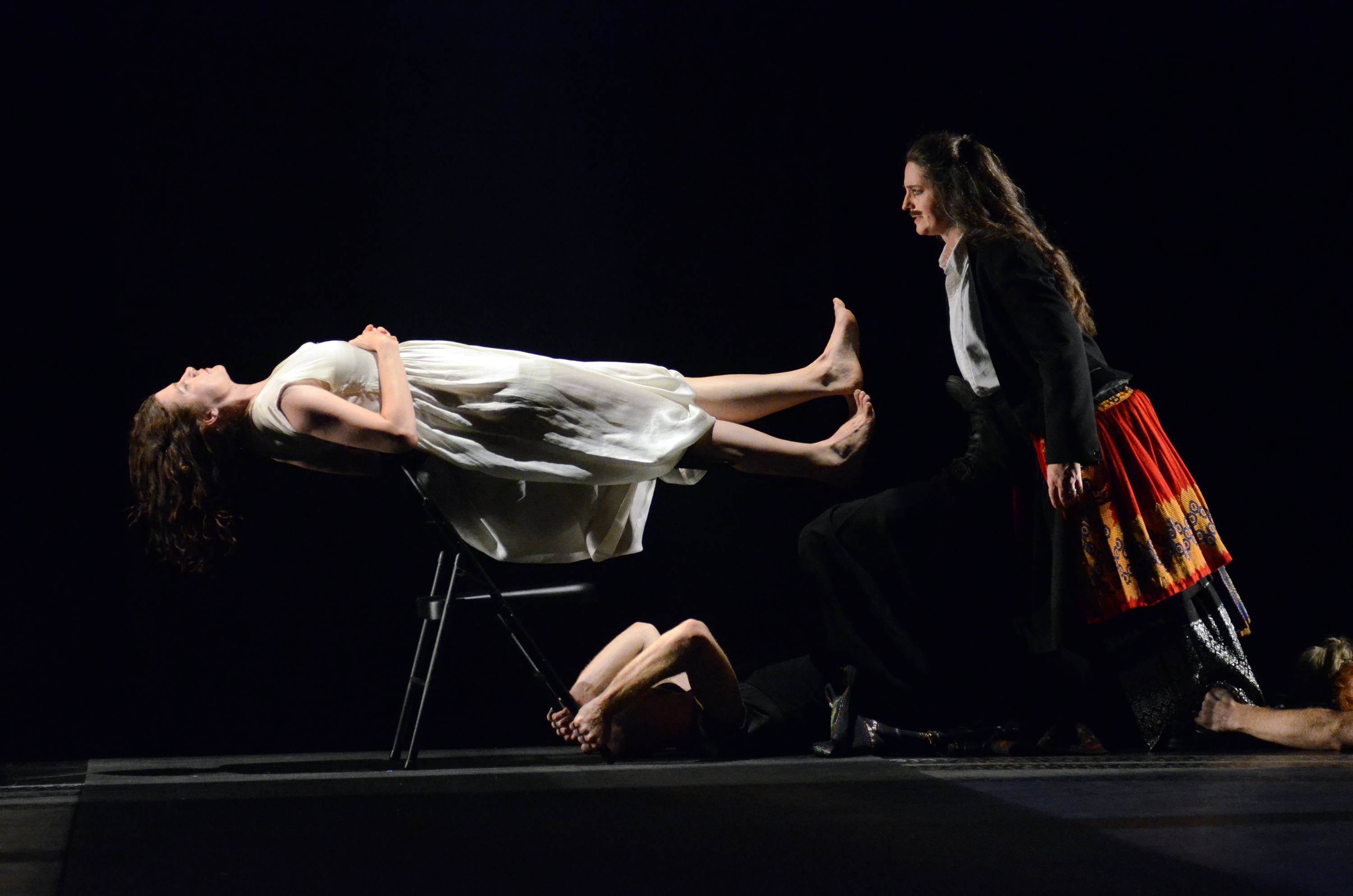Introduction
Under the collaborative leadership of choreographer Annie-B Parson and Paul Lazar, Big Dance Theater creates evening-length performances that depict intrinsic and indispensable properties of life, from the epic to the quotidian. Drawing inspiration from literary giants such as Mark Twain, Gustave Flaubert, Euripides, and Junichiro Tanizaki, Parson and Lazar combine multiple performance elements, drawing on techniques from both dance and theater. Short stories or plays serve as a seed of inspiration, a launching-off point, or a structure against which to wriggle. Big Dance Theater’s goal, as Parson and Lazar have been known to comment, is to “saturate dance with theater and theater with dance.” They fuse multiple forms to delve into the complexity of human interactions. As they explain it, they: “generat[e] each piece over months of collaboration with its associate artists, a long-standing, ever-evolving group of actors, dancers, composers and designers.” Creating something new out of something old is a driving force in the productions of Big Dance Theater.
In addition to understanding conventions from theater and dance, Parson and Lazar share a rich visual imagination that leads to exciting collaborations for the design of the works, for sets, video projections, and lighting. They use costumes and set pieces to trigger connections which evoke a variety of times, places, and temperaments. While sometimes Big Dance Theater finds itself too theatrical and text-driven for the dance world, and too abstract and choreography-driven for the theater world, they have long been welcome at Jacob’s Pillow, beginning with their Pillow debut in 2000. This support was made evident when Big Dance Theater was the recipient of the first annual Jacob’s Pillow Dance Award in 2007.
A Simple Heart
A Simple Heart (1997), performed at the Pillow in 2000, takes its inspiration from Gustave Flaubert’s story by the same name. The dance theater version maintains the simple arc of Flaubert’s story, with starkly rich tableaux replacing Flaubert’s spare paragraphs and his narrative giving way to episodic occurrences. While Flaubert himself referred to the story as “an account of an obscure life,” both he and Big Dance Theater treat the modest tale of the loves and losses of the character of the maid with elegiac delicacy. Big Dance Theater combines dance with character development and the occasional use of spoken or written text to posit the story.
The story, set in the provincial French countryside in the 19th-century, follows the life of the maidservant, un-befittingly named Félicité. Weathered by a long-ago broken heart, Félicité showers affection on members of the household, the demanding aristocratic mother and her much doted-upon daughter. The dancers in A Simple Heart embody the story, showing the flux of the passing years with nuanced gesture, meticulously choreographed facial expressions, and abstracted actions. Parson’s choreography thoughtfully captures the lives of characters moving at different rhythms and on different social levels. Two dancers portray the singular character of maidservant Félicité. They move with angular intensity in contrast to the daughter who floats through a waltz.
Shunkin
Shunkin (2001), seen at the Pillow in 2002, takes its title, certain plot elements and characters from a short story by one of the premier Japanese writers of the 20th century, Junichiro Tanizaki. Tanizaki was born in the 19th century and lived until 1965, spanning three emperors’ reigns and witnessing many horrific and beautiful occurrences in Japanese life. His works, which often fuse traditional and experimental concepts of storytelling, are celebrated for their investigation of the tensions between traditions of Japanese life and a fascination with Western culture. Big Dance Theatre combined Tanizaki’s exquisite prose with interviews from present-day rock stars.
The work is and is not Tanizaki’s story “Shunkin-sho” (“A Portrait of Shunkin”). Parson and Lazar have no interest in re-telling a story one could just as easily read. Rather, they find the essential elements for themselves and then think about them from their own perspective. Tanizaki’s story is integral, but its throughline is disrupted. While the story is never fully explained, as the piece progresses it becomes quite clear. The text, written by Paul Lazar and company members in collaboration, is as choreographed as the movement.
It was the production of Shunkin that led the Japan Society in New York to commission a new work called The Other Here (2007) from Big Dance Theater. Lazar and Parson asked Japan Society artistic director Yoko Shioya for Japanese sources, which led to their investigation of works by writer Masuji Ibuse. Like Tanizaki, Ibuse was equally interested in Eastern and Western writing, as seen in his short stories and novels. Ibuse’s stories were essential, but for Big Dance Theater, one source is never enough. Dance writer Deborah Jowitt remarked,
When it comes to layering and intercutting disparate texts and images, no one can match Big Dance Theater. The mysterious resonance that emanates from their works transcends their sources.”
A trip to Japan and Okinawa provided further research opportunities for Lazar and Parson, who added even more elements to the mix—the folk-rock music of Okinawa native Shoukichi Kina and traditional dances from Okinawa. A Pillow co-commission and Creative Development Residency at the Pillow contributed to the creative process. They discovered one of their sources during the residency. Before Ted Shawn founded Jacob’s Pillow, he and Ruth St Denis directed a company that toured around the world. In 1925 and 1926, they toured all over Asia. In the Jacob’s Pillow Archives are silent films shot by St. Denis’s brother, known as Brother St. Denis, and these were brought to the attention of Parson and Lazar by the Pillow’s Director of Preservation, Norton Owen.
The work, using set pieces, elaborate costumes, music, and threads of storytelling, is at once minimalist and overflowing. In Big Dance Theater’s interpretation of Ibuse’s work, the stories meld and fragment. Parson and Lazar layer them with movement, music, and a fragile film of a fish.
Parson described the way Big Dance Theater brought these disparate strands together as, “dislocating a Japanese story, of rural life long ago, into a contemporary sales conference. The task…came to us organically through the stirring and sampling of materials—it’s our version of the creative process.” The Other Here hovers at the edges of clarity and pleasurable ambiguity.
Supernatural Wife
In 2011, Big Dance performed the U.S. premiere of Supernatural Wife (2011) at the Pillow, what Roslyn Sulcas in the New York Times described as “their no-doubt very particular take on [Euripides’s] Greek tragedy Alcestis.”

Euripides, the Ancient Greek playwright, has long been an object of critical debate for a couple of significant reasons. First, although known for tragedies, some aspects of his work seem more at home in comedy. Second, his interest in women. Not just women as characters, although he wrote about Medea and Helen of Troy, but he returned again and again to the theme of relationships between men and women, questioning the role of women in the democratic state, in which men had all the power. This is not to claim Euripides as a proto-feminist. Classics scholar Philip Vellacott contends, “His plays contain, hidden below the popular surface, an appeal to men to stop deceiving themselves about the benevolence of their behavior to women.” Philip Vellacott, “Introduction” to Euripides, Alcestis and Other Plays. Penguin, 1954. Fractious critical response to the plays of Euripides is exactly the kind of territory in which Big Dance Theater thrives. They expertly dissect paradoxes between tragedy and comedy while being comfortable with contradiction and opposition.


The story of Alcestis is rich and direct: Because of an intervention by the god Apollo, Admetus escapes death, but someone must offer to die in his place. He wrongfully assumes one of his elderly parents will volunteer. His wife, the beautiful queen Alcestis, sacrifices her life. Alcestis is wrestled from death and restored to life leading to the possibility of a happy ending to what at first seemed to be an unavoidable tragedy. Supernatural Wife included Euripides’s text in a translation by poet and essayist Anne Carson. With her permission, Parson and Lazar cut half of the language, leaving the essential story, but distilled and disrupted.
What is critical is how the moving, the dancing, and the staging tells the story. The movement includes stylized Greek folk dance, gestures, exaggerated postures, and pedestrian movement, among other things.
Alan Smithee Directed This Play: Triple Feature
With Alan Smithee Directed This Play: Triple Feature (2014), Big Dance Theater moved away from literature as source material to one of the simultaneously best known and most anonymous of Hollywood directors.


Alan Smithee is the long-used pseudonym, sanctioned by the Directors Guild of America, taken by movie directors who feel they’ve lost creative control of a project. In the world of Big Dance Theater, stories and characters are set free from their original contexts and set to roam across national borders and historical moments.
No matter what the source material for Big Dance Theater’s works, Parson and Lazar do not merely re-tell the stories. Rather, they reconceptualize the written words and physicalize them—making them life-size, living and breathing, three-dimensional. As the eloquent German writer Walter Benjamin, says: “It is half the art of storytelling to keep a story free from explanation as one reproduces it.”Walter Benjamin, Illuminations: Essays and Reflections. trans. Harry Zohn, 1969. Parson and Lazar understand the pleasure that stories offer, clarifying without explaining, finding in them essential and embodied powers.
PUBLISHED March 2017